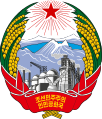Emblem of North Korea
| National Emblem of the Democratic People's Republic of Korea | |
|---|---|
 | |
| Armiger | Democratic People's Republic of Korea |
| Adopted | 1993 |
| Motto | Democratic People's Republic of Korea |
| Earlier version(s) | July 1948, September 1948 |
| National Emblem of the Democratic People's Republic of Korea | |
| Chosŏn'gŭl | 조선민주주의인민공화국의 국장 |
|---|---|
| Revised Romanization | Joseonminjujuuiinmingonghwagugui gukjang |
| McCune–Reischauer | Chosŏnminjujuŭiinmin'gonghwagugŭi kukchang |
 |
| Part of a series on the |
| Culture of Korea |
|---|
| Society |
| Arts and literature |
| Other |
| Symbols |
|
The emblem of North Korea is a
Prior to the establishment of the North Korean state, two former versions were in use from 1945 to 1947.
History
During the
However, in July 1948 as the division of Korea loomed, North Korea adopted its first constitution. This constitution defined the North Korean emblem, but the emblem was in use for only two months. It features a furnace, as opposed to a hydroelectric plant on later designs.[1]
On September 9, 1948, the
-
Emblem of the People's Republic of Korea from 1945 to 1946
-
Reconstruction of the first equivalent of an emblem published in Chŏngro in 1946
-
The emblem defined by the 1948 constitution but only used for two months
-
The emblem used from the founding of North Korea until 1993 features a generic mountain range
-
A variant of the emblem printed by the Foreign Languages Publishing House in 1960, showing the generic mountain range, as well as the design of the dam typical of the post-1993 standard
-
Emblem used by the President of the State Affairs of North Korea (2016–present)
Features
The national emblem of the Democratic People's Republic of Korea bears the design of a grand hydroelectric power station under Mt. Paektu, the sacred mountain of the revolution, and the beaming light of a five-pointed red star, with ears of rice forming an oval frame, bound with a red ribbon bearing the inscription "The Democratic People’s Republic of Korea."
Article 169 of the
The emblem features the Sup'ung dam under Mount Paektu and a power line as the
While the design of the hydroelectric plant is generic in appearance,
The emblem, and all of its predecessors, follows the basic
-
Emblem at the North Korean embassy in Prague, Czech Republic
-
Emblem at the fence of the North Korean embassy in Prague, Czech Republic
-
The emblem above the entrance to theNorth Korean embassy in Moscow.
-
North Korean Won
See also
References
- ^ a b c d e Fyodor Tertitskiy (September 23, 2014). "The Evolution of North Korea's Coat of Arms". Daily NK. Retrieved August 2, 2015.
- ^ Tertitskiy, Fyodor (April 10, 2018). "What North Korea's army flags can teach us about its recent history". NK News. Retrieved September 9, 2018.
- ISBN 978-9946-0-1099-1. Archived from the original (PDF) on June 8, 2016.)
{{cite book}}: CS1 maint: others (link - ISBN 978-0-16-088278-4.
- ^ ISBN 978-90-04-18019-2.
- ^ Oliver Hotham (May 22, 2015). "Lights out in Pyongyang? North Korea's energy crisis". NK News. Retrieved August 3, 2015.
Further reading
- 100 Questions and Answers: Do You Know about Korea?. Pyongyang: OCLC 21301721.
- Thomas, Dean (2014). "Flags and Emblems of the Democratic People's Republic of Korea". Raven: A Journal of Vexillology. 21: 95–115. ISSN 1071-0043.
External links
- National Emblem of the DPRK Archived April 29, 2016, at the Wayback Machine at Naenara











